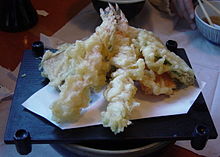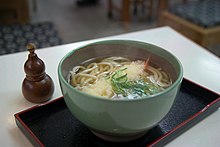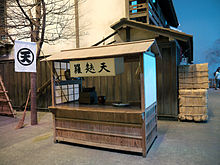Tempura




Tempura (天ぷら or 天麩羅, tenpura) is a Japanese dish of seafood or vegetables that have been battered and deep fried.
Preparation
Batter
A light batter is made of cold water (sometimes sparkling water is used to keep the batter light)[1] and soft wheat flour (cake, pastry or all-purpose flour).[2][3][4] Eggs, baking soda or baking powder, starch, oil, and/or spices may also be added. Tempura batter is traditionally mixed in small batches using chopsticks for only a few seconds, leaving lumps in the mixture that, along with the cold batter temperature, result in the unique fluffy and crisp tempura structure when cooked. The batter is often kept cold by adding ice, or by placing the bowl inside a larger bowl with ice in it. Overmixing the batter will result in activation of wheat gluten, which causes the flour mixture to become chewy and dough-like when fried.
Specially formulated tempura flour is available in worldwide supermarkets. This is generally light (low-gluten) flour, and occasionally contains leaveners such as baking powder.
Tempura generally does not use breadcrumbs (panko) in the coating. Generally, fried foods which are coated with breadcrumbs are considered to be furai, Japanese-invented Western-style deep fried foods, such as tonkatsu or ebi furai (fried prawn).
Frying
Thin slices or strips of vegetables or seafood are dipped in the batter, then briefly deep-fried in hot oil. Vegetable oil or canola oil are most common; however, tempura was traditionally cooked using sesame oil[citation needed]. Many specialty shops still use sesame oil or tea seed oil, and it is thought certain compounds in these oils help to produce light, crispier batter[citation needed].
When cooking shellfish, squid, or hard-skinned watery vegetables, such as bell pepper or eggplant, the skin is usually scored with a knife to prevent the ingredients from bursting during cooking, which can cause serious burns from splashing oil.
Oil temperature is generally kept between 160 and 180 degrees Celsius, depending on the ingredient[citation needed]. To preserve the natural flavor and texture of the ingredients, care is taken not to overcook tempura. Cooking times range between a few seconds for delicate leaf vegetables, to several minutes for thick items or large kaki-age fritters[citation needed].
The bits of batter (known as tenkasu) are scooped out between batches of tempura, so they do not burn and leave a bad flavor in the oil. A small mesh scoop (Ami jakushi) is used for this purpose. Tenkasu are often reserved as ingredients in other dishes or as a topping.
Ingredients
Ingredients in traditional tempura include: Template:Multicol
- carrot
- gobo (burdock, Arctium lappa)
- green beans
- sweet potato
- potato
- renkon (lotus root)
- shiitake mushroom
- pumpkin
- mushrooms
- bamboo shoots
- okra
Serving and presentation
Cooked bits of tempura are either eaten with dipping sauce, salted without sauce, or used to assemble other dishes. Tempura is commonly served with grated daikon and eaten hot immediately after frying. In Japan, it is often found in bowls of soba or udon soup often in the form of a shrimp, shiso leaf, or fritter. The most common sauce is tentsuyu sauce (roughly three parts dashi, one part mirin, and one part shoyu). Alternatively, tempura may be sprinkled with sea salt before eating. Mixtures of powdered green tea and salt or yuzu and salt are also used.
Kakiage is a type of tempura made with mixed vegetable strips, such as onion, carrot, and burdock, and sometimes including shrimp, which are deep fried as small round fritters.
Tempura is also used in combination with other foods. When served over soba (buckwheat noodles), it is called tempura soba or tensoba. Tempura is also served as a donburi dish where tempura shrimp and vegetables are served over steamed rice in a bowl (tendon) and on top of udon soup (tempura udon).


History
Origins
Tempura was introduced to Japan in the mid-sixteenth century by Portuguese[5] Jesuits,[6] during the same period that panko and such dishes as tonkatsu were also introduced from Portugal. Tokugawa Ieyasu, founder and first shogun of the Tokugawa shogunate of Japan, reportedly loved tempura[citation needed].
Etymology
The word "tempura", or the technique of dipping fish and vegetables into a batter and frying them, comes from the word "tempora", a Latin word meaning "times", "time period" used by both Spanish and Portuguese missionaries to refer to the Lenten period or Ember Days (ad tempora quadragesimae), Fridays, and other Christian holy days. Ember Days or quattuor tempora refer to holy days when Catholics avoid meat and instead eat fish or vegetables.[citation needed] The idea that the word "tempura" may have been derived from the Portuguese noun tempero, meaning a spicy condiment or peppery seasoning, or from the verb temperar, meaning "to season" has not been substantiated.[6] However, the Japanese language could easily have assumed the word "tempero" as is, without changing any vowels as both languages are phonetically similar.[7] There is still today a dish in Portugal very similar to tempura called peixinhos da horta, "garden fishies."
The term "tempura" is thought to have gained popularity in southern Japan; it became widely used to refer to any sort of food prepared using hot oil, including some already existing Japanese foods. Today, the word "tempura" is also commonly used to refer to satsuma age, a fried fish cake which is made without batter.
Variations
Japan
In Japan, restaurants specializing in tempura are called tenpura-ya and range from inexpensive fast food chains to very expensive five-star restaurants. Many restaurants offer tempura as part of a set meal or a bento (lunch box), and it is also a popular ingredient in take-out or convenience store bento boxes. The ingredients and styles of cooking and serving tempura vary greatly through the country, with importance being placed on using fresh, seasonal ingredients.
Outside of Japan
Outside Japan (as well as recently in Japan), there are many nontraditional and fusion uses of tempura. Chefs over the world include tempura dishes on their menus, and a wide variety of different batters and ingredients are used, including the nontraditional broccoli, zucchini, asparagus and chuchu. More unusual ingredients may include nori slices, dry fruit such as banana, and ice cream. American restaurants are known to serve tempura in the form of various meats, particularly chicken, and cheeses, usually mozzarella. A variation is to use panko (bread crumbs), which results in a crisper consistency than tempura batter. Using panko in Japan would no longer qualify the dish as tempura. It would become something else called fry or pronounced in Japanese as fuurai. Tempura (particularly shrimp) is often used as a filling in makizushi. A more recent variation of tempura sushi has entire pieces of sushi being dipped in batter and tempura-fried.
In northern Taiwan, tempura is also known as tiānfùluō 天婦羅 and can be found at night markets such as Shilin Night Market and Keelung Temple Night Market. The ingredients and method used for making Taiwanese tempura are completely different from Japanese tempura, and they share only the name. In southern Taiwan, however, it is known as hétián 和田 and is more the counterpart to oden. Oden is generally known as 關東煮 or "Kantō cooking" in reference to the Kantō region of Japan.
In Bangladesh the blossoms of pumpkins or marrows are often deep fried with a gram or rice flour spice mix creating a Bengali style tempura known as kumro phool bhaja.
See also
- Japanese words of Portuguese origin
- Tonkatsu, a Japanese deep fried pork cutlet
- Pakora, an Indian food resembling tempura
References
- ^ fishcooking.about.com
- ^ Okamoto, Osamu (1994). Sam Okamoto's incredible vegetables. Pelican Publishing Company. p. 31. ISBN 1-56554-025-5.
- ^ Meyer, Arthur L.; Vann, Jon M. (2003). The Appetizer Atlas: A World of Small Bites. John Wiley and Sons. p. 235. ISBN 0-471-41102-7.
- ^ Kobayashi, Katsuyo (2000). The quick and easy Japanese cookbook: great recipes from Japan's favorite TV cooking show host. Kodansha International. p. 23. ISBN 4-7700-2504-1.
- ^ Lemos, Charles (1998). Everybody's San Francisco Cookbook. Good Life Publications. p. 240. ISBN 978-1-886776-01-2.
- ^ a b Morieda, Takashi. "Tracking Down Tempura". The World of Kikkoman. Retrieved 2007-12-13.
- ^ "Japanese Writers' House Newsletter". 2007-10-10. Retrieved 2008-01-11.
